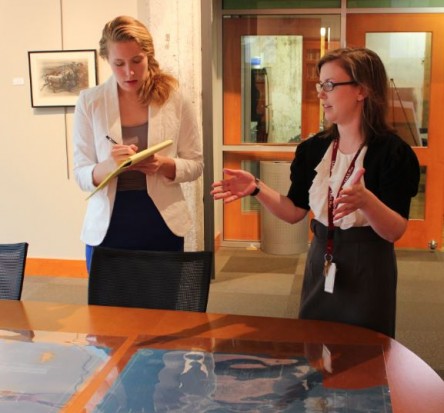In this day and age the term ‘arcade’ typically brings to mind coin-operated machines featuring Pac Man. However, the word also denotes an arch or arc, which describes the key-feature of 20th century European marketplaces.
Scheduled to be completed in the fall of 2013, Little Rock’s newest River Market addition has been dubbed, “The Arcade.” Although this space won’t house rows of games, it will serve multiple purposes. The joint project between Moses Tucker Real Estate and The Central Arkansas Library System will include a theatre, office spaces for the Little Rock Film Festival, and even a restaurant.
During the groundbreaking last fall postcards were handed out that depicted Little Rock’s original arcade building.
Shannon Lausch, an archivist for the Center for Arkansas History and Culture (CAHC), was inspired by that postcard.
She turned to the archives to find information on this former landmark of Little Rock. “The postcard show[ed] the arcade building and so that’s kind of what made me think, ‘I wonder what we have about it.’”
Her fruitful search turned up a series of architectural drawings of the original ‘City Market and Arcade’ building, which was constructed in 1914, nearly a hundred years ago.
The blueprints gave Lausch the motivation she needed to delve further. In her free time she would see w hat else she could find on her growing project.
hat else she could find on her growing project.
She explained: “Most of what archivists do is actually process the collection and leave others to do stuff like this. […] We’ll do side projects like these to illustrate our holdings.”
Her side project eventually snowballed into a historical investigation. Beyond the blueprints and a few construction photographs, Lausch was left without a concrete time-line. “I really had to do some digging to find out more information about it. […] I’ve had to go to other archives and repositories and dig for a little more information.”
Once the information began to fit together, Lausch realized she had the workings of a valuable public exhibit. “We applied for a grant from the Arkansas Humanities Council to do some exhibit planning as well as figuring out how to design the exhibit.”
Since receiving the 1,000 dollar grant, a committee has been put together to work through the details of the exhibit. Currently the committee is talking with Moses Tucker Real Estate to see about placing the exhibit in the lobby of the new arcade.
The display will include the blueprints as well as photographs of construction scenes. A narrative of Little Rock’s social scene will also be a part of the set-up. The building marks modern strides for the city as Lausch said, “It’s representative of Little Rock’s transformation from a River Town to a city.”
The original structure covered the entire 600 block of Louisiana Street, and its grand opening was no less exuberant. Lausch explained: “When the building opened up […] there was this entire festival surrounding it and there was a lot of fanfare. “
The technology and design of the building were extremely modern for the turn of the century. In the archives of The Arkansas Catholic, Little Rock’s official Catholic newspaper, The Southern Guardian boasts in its January 31, 1914 issue: “There will be more than 100 market stalls, three-fourths of which will have refrigerator appliances of the latest and most sanitary designs. […] The City and Market Arcade is indeed a great feature in the growth of the flourishing City of Roses.”
Initially the building was destined a market hub catering to the city’s grocery needs. Lausch said, “It was a place people could go to buy groceries. You had all these different people in there so you could compare prices.”
As time progressed the building morphed into a recognizable modern mall. The focus went from food to other merchandise such as musical instruments and hardware needs.
Whether housing food or retail goods, the most prominent feature of the building throughout its existence was the open-ended, arched passageway that bisected the building.
The building was demolished in 1960 to become the site of the Downtowner Motor Inn. In 2004 the Inn was demolished and since then the space has served as a parking lot.
Unfortunately today it’s difficult to find many people who remember the building in its hey-day. Those around with vivid memories of the structure whom Lausch has interviewed consistently comment on the white ceramic tiles and the arched ceiling that were distinctive to its form.
The structure was once a hub in Little Rock, and its history is rich enough to share in this future exhibit. Lausch is excited to get the community involved with its own bit of local history via the exhibit.
Originally from the Chicago area, she marvels in the colorful history of Little Rock that she’s found in the stories of buildings as well as prominent people who call this city home. She said of the city: “People are really passionate about their history [here]. In this project people that I’ve talked to are really enthusiastic even if they’re not in the history business.”
Source: http://www.arkansas-catholic.org/
This article was provided by Becca Bona of the Daily Record, the Daily Newspaper of Law and Business Information. It originally appeared on Friday, June 7, 2013.

